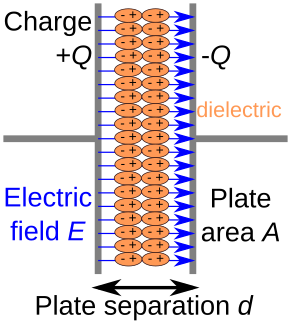 W
WA dielectric is an electrical insulator that can be polarized by an applied electric field. When a dielectric material is placed in an electric field, electric charges do not flow through the material as they do in an electrical conductor but only slightly shift from their average equilibrium positions causing dielectric polarization. Because of dielectric polarization, positive charges are displaced in the direction of the field and negative charges shift in the direction opposite to the field. This creates an internal electric field that reduces the overall field within the dielectric itself. If a dielectric is composed of weakly bonded molecules, those molecules not only become polarized, but also reorient so that their symmetry axes align to the field.
 W
WBakelite or polyoxybenzylmethylenglycolanhydride was the first plastic made from synthetic components. It is a thermosetting phenol formaldehyde resin, formed from a condensation reaction of phenol with formaldehyde. It was developed by the Belgian-American chemist Leo Baekeland in Yonkers, New York, in 1907.
 W
WBoPET is a polyester film made from stretched polyethylene terephthalate (PET) and is used for its high tensile strength, chemical and dimensional stability, transparency, reflectivity, gas and aroma barrier properties, and electrical insulation.
 W
WA corona ring, also called an anti-corona ring, is a toroid of conductive material, usually metal, which is attached to a terminal or other irregular hardware piece of high voltage equipment. The role of the corona ring is to distribute the electric field gradient and lower its maximum values below the corona threshold, either preventing corona discharge entirely or transferring its destructive effects from the valuable hardware to the expendable ring. Corona rings are used on very high voltage power transmission insulators and switchgear, and on scientific research apparatus that generates high voltages. A very similar related device, the grading ring, is used around insulators.
 W
WElectrical tape is a type of pressure-sensitive tape used to insulate electrical wires and other materials that conduct electricity. It can be made of many plastics, but vinyl is most popular, as it stretches well and gives an effective and long lasting insulation. Electrical tape for class H insulation is made of fiberglass cloth.
 W
WIn electrical engineering, treeing is an electrical pre-breakdown phenomenon in solid insulation. It is a damaging process due to partial discharges and progresses through the stressed dielectric insulation, in a path resembling the branches of a tree. Treeing of solid high-voltage cable insulation is a common breakdown mechanism and source of electrical faults in underground power cables.
 W
WFriction tape is a type of woven cloth adhesive tape, historically made of cotton, impregnated with a rubber-based adhesive. Sticky on both sides, it is mainly used by electricians to insulate splices in electric wires and cables. The rubber-based adhesive provides a degree of protection from liquids and corrosion, while the cloth mesh protects against punctures and abrasion. It has been universally supplanted by PVC-based electrical tape.
 W
WGlass is a non-crystalline, often transparent amorphous solid, that has widespread practical, technological, and decorative use in, for example, window panes, tableware, and optics. Glass is most often formed by rapid cooling (quenching) of the molten form; some glasses such as volcanic glass are naturally occurring. The most familiar, and historically the oldest, types of manufactured glass are "silicate glasses" based on the chemical compound silica, the primary constituent of sand. Soda-lime glass, containing around 70% silica, accounts for around 90% of manufactured glass. The term glass, in popular usage, is often used to refer only to this type of material, although silica-free glasses often have desirable properties for applications in modern communications technology. Some objects, such as drinking glasses and eyeglasses, are so commonly made of silicate-based glass that they are simply called by the name of the material.
 W
WThe Hemingray Glass Company was an American glass manufacturing company founded by Robert Hemingray and Ralph Gray in Cincinnati in 1848. In its early years, the company went through numerous and frequent name changes, including Gray & Hemingray; Gray, Hemingray & Bros.; Gray, Hemingray & Brother; Hemingray Bros. & Company; and R. Hemingray & Company before incorporating into the Hemingray Glass Company, Inc. in 1870. The Hemingray Glass Company had factories in Cincinnati and Covington, Kentucky with main production in Muncie, Indiana. Although Hemingray was best known for its telegraph insulators, the company produced many other glass items including bottles, fruit jars, pressed glass dishes, tumblers, battery jars, fishbowls, lantern globes, and oil lamps. In 1933, the Owens-Illinois Glass Company purchased the company but retained the production facility in Muncie under the Hemingray name.
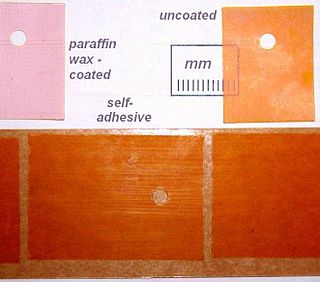 W
WKapton is a polyimide film developed by DuPont in the late 1960s that remains stable across a wide range of temperatures, from −269 to +400 °C. Kapton is used in, among other things, flexible printed circuits and space blankets, which are used on spacecraft, satellites, and various space instruments.
 W
WA Leyden jar is an antique electrical component which stores a high-voltage electric charge between electrical conductors on the inside and outside of a glass jar. It typically consists of a glass jar with metal foil cemented to the inside and the outside surfaces, and a metal terminal projecting vertically through the jar lid to make contact with the inner foil. It was the original form of the capacitor.
 W
WA Lichtenberg figure, or Lichtenberg dust figure, is a branching electric discharge that sometimes appears on the surface or in the interior of insulating materials. Lichtenberg figures are often associated with the progressive deterioration of high voltage components and equipment. The study of planar Lichtenberg figures along insulating surfaces and 3D electrical trees within insulating materials often provides engineers with valuable insights for improving the long-term reliability of high-voltage equipment. Lichtenberg figures are now known to occur on or within solids, liquids, and gases during electrical breakdown.
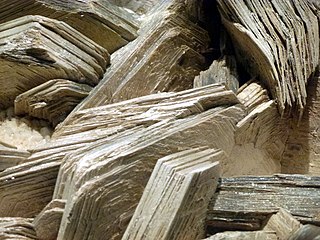 W
WMicas are a group of minerals whose outstanding physical characteristic is that individual mica crystals can easily be split into extremely thin elastic plates. This characteristic is described as perfect basal cleavage. Mica is common in igneous and metamorphic rock and is occasionally found as small flakes in sedimentary rock. It is particularly prominent in many granites, pegmatites, and schists, and "books" of mica several feet across have been found in some pegmatites.
 W
WNeoprene is a family of synthetic rubbers that are produced by polymerization of chloroprene. Neoprene exhibits good chemical stability and maintains flexibility over a wide temperature range. Neoprene is sold either as solid rubber or in latex form and is used in a wide variety of applications, such as laptop sleeves, orthopaedic braces, electrical insulation, liquid and sheet-applied elastomeric membranes or flashings, and automotive fan belts.
 W
WNylon is a generic designation for a family of synthetic polymers composed of polyamides. Nylon is a thermoplastic silky material that can be melt-processed into fibers, films, or shapes. Nylon polymers can be mixed with a wide variety of additives to achieve many different property variations. Nylon polymers have found significant commercial applications in fabric and fibers, in shapes, and in films.
 W
WThe plasma pencil is a dielectric tube where two disk-shaped electrodes of about the same diameter as the tube are inserted, and are separated by a small gap. Each of the two electrodes is made of a thin copper ring attached to the surface of a centrally perforated dielectric disk. The plasma is ignited when nanoseconds-wide high voltage pulses at kHz repetition rate are applied between the two electrodes and a gas mixture is flown through the holes of the electrodes. When a plasma is ignited in the gap between the electrodes, a plasma plume reaching lengths up to 12 cm is launched through the aperture of the outer electrode and into the surrounding room air. The cold plasma plume emitted by the plasma pencil can be used to kill bacteria without harming skin tissue.
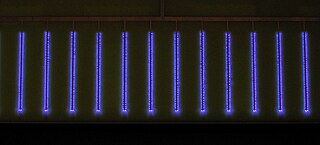 W
WPlasma actuators are a type of actuator currently being developed for aerodynamic flow control. Plasma actuators impart force in a similar way to ionocraft. Plasma flows control has drawn considerable attention and been used in boundary layer acceleration, airfoil separation control, forebody separation control, turbine blade separation control, axial compressor stability extension, heat transfer and high-speed jet control.
 W
WPlastics are a wide range of synthetic or semi-synthetic materials, that use polymers as a main ingredient. The plasticity during production makes it possible for plastic to be moulded, extruded or pressed into solid objects of various shapes, making it an adaptable material for many different uses. This adaptability, plus a wide range of beneficial properties, such as being light weight, durable and flexible, alongside cheap production processes has led to widespread adoption in contemporary society. Plastics typically are made through human industrial systems. Most modern plastics are derived from fossil fuel based petrochemicals like natural gas or petroleum; however, recent industrial methods use variants made from renewable materials such as derivatives of corn or cotton.
 W
WPoly(methyl methacrylate) (PMMA), also known as acrylic, acrylic glass, or plexiglass, as well as by the trade names Crylux, Plexiglas, Acrylite, Astariglas, Lucite, Perclax, and Perspex, among several others, is a transparent thermoplastic often used in sheet form as a lightweight or shatter-resistant alternative to glass. The same material can be used as a casting resin or in inks and coatings, among many other uses.
 W
WPolycarbonates (PC) are a group of thermoplastic polymers containing carbonate groups in their chemical structures. Polycarbonates used in engineering are strong, tough materials, and some grades are optically transparent. They are easily worked, molded, and thermoformed. Because of these properties, polycarbonates find many applications. Polycarbonates do not have a unique resin identification code (RIC) and are identified as "Other", 7 on the RIC list. Products made from polycarbonate can contain the precursor monomer bisphenol A (BPA).
 W
WPolyester is a category of polymers that contain the ester functional group in every repeat unit of their main chain. As a specific material, it most commonly refers to a type called polyethylene terephthalate (PET). Polyesters include naturally occurring chemicals, such as in the cutin of plant cuticles, as well as synthetics such as polybutyrate. Natural polyesters and a few synthetic ones are biodegradable, but most synthetic polyesters are not. The material is used extensively in clothing.
 W
WPolyethylene or polythene is the most common plastic in use today. It is a polymer, primarily used for packaging. As of 2017, over 100 million tonnes of polyethylene resins are being produced annually, accounting for 34% of the total plastics market.
 W
WPolyimide is a polymer of imide monomers belonging to the class of high performance plastics. With their high heat-resistance, polyimides enjoy diverse applications in roles demanding rugged organic materials, e.g. high temperature fuel cells, displays, and various military roles. A classic polyimide is Kapton, which is produced by condensation of pyromellitic dianhydride and 4,4'-oxydianiline.
 W
WPolymethylpentene (PMP), also known as poly(4-methyl-1-pentene), is a thermoplastic polymer of 4-methyl-1-pentene. It is used for gas-permeable packaging, autoclavable medical and laboratory equipment, microwave components, and cookware. It is commonly called TPX, which is a trademark of Mitsui Chemicals.
 W
WPolypropylene (PP), also known as polypropene, is a thermoplastic polymer used in a wide variety of applications. It is produced via chain-growth polymerization from the monomer propylene.
 W
WPolytetrafluoroethylene (PTFE) is a synthetic fluoropolymer of tetrafluoroethylene that has numerous applications. The commonly known brand name of PTFE-based formulas is Teflon by Chemours, a spin-off from DuPont, which originally discovered the compound in 1938.
 W
WPolyvinyl chloride is the world's third-most widely produced synthetic plastic polymer. About 40 million tons of PVC are produced each year.
 W
WPorcelain is a ceramic material made by heating materials, generally including a material like kaolin, in a kiln to temperatures between 1,200 and 1,400 °C. The strength, and translucence of porcelain, relative to other types of pottery, arises mainly from vitrification and the formation of the mineral mullite within the body at these high temperatures. Though definitions vary, porcelain can be divided into three main categories: hard-paste, soft-paste and bone china. The category that an object belongs to depends on the composition of the paste used to make the body of the porcelain object and the firing conditions.
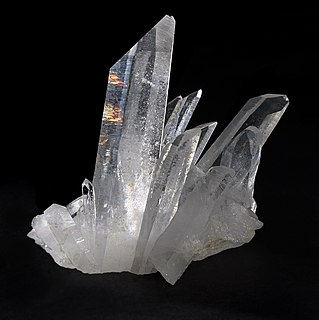 W
WQuartz is a hard, crystalline mineral composed of silicon and oxygen atoms. The atoms are linked in a continuous framework of SiO4 silicon-oxygen tetrahedra, with each oxygen being shared between two tetrahedra, giving an overall chemical formula of SiO2. Quartz is the second most abundant mineral in Earth's continental crust, behind feldspar.
 W
WRutilated quartz is a variety of quartz which contains acicular (needle-like) inclusions of rutile. It is used for gemstones. These inclusions mostly look golden, but they also can look silver, copper red or deep black. They can be distributed randomly or in bundles, which sometimes are arranged star-like, and they can be sparse or dense enough to make the quartz body nearly opaque. While otherwise inclusions often reduce the value of a crystal, rutilated quartz in fact is valued for the quality and beauty of these inclusions.
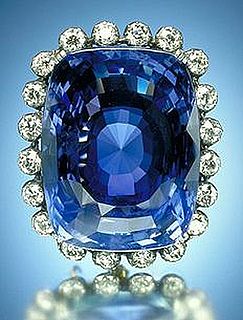 W
WSapphire is a precious gemstone, a variety of the mineral corundum, consisting of aluminium oxide (α-Al2O3) with trace amounts of elements such as iron, titanium, chromium, vanadium, or magnesium. It is typically blue, but natural "fancy" sapphires also occur in yellow, purple, orange, and green colors; "parti sapphires" show two or more colors. Red corundum stones also occur but are called rubies not sapphires. Pink colored corundum may be classified either as ruby or sapphire depending on locale. Commonly, natural sapphires are cut and polished into gemstones and worn in jewelry. They also may be created synthetically in laboratories for industrial or decorative purposes in large crystal boules. Because of the remarkable hardness of sapphires – 9 on the Mohs scale (the third hardest mineral, after diamond at 10 and moissanite at 9.5) – sapphires are also used in some non-ornamental applications, such as infrared optical components, high-durability windows, wristwatch crystals and movement bearings, and very thin electronic wafers, which are used as the insulating substrates of special-purpose solid-state electronics such as integrated circuits and GaN-based blue LEDs.
 W
WSlate is a fine-grained, foliated, homogeneous metamorphic rock derived from an original shale-type sedimentary rock composed of clay or volcanic ash through low-grade regional metamorphism. It is the finest grained foliated metamorphic rock. Foliation may not correspond to the original sedimentary layering, but instead is in planes perpendicular to the direction of metamorphic compression.
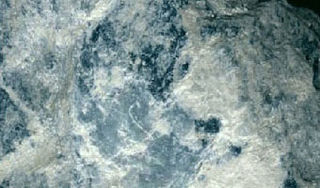 W
WSoapstone is a talc-schist, which is a type of metamorphic rock. It is composed largely of the magnesium rich mineral talc. It is produced by dynamothermal metamorphism and metasomatism, which occur in the zones where tectonic plates are subducted, changing rocks by heat and pressure, with influx of fluids, but without melting. It has been a medium for carving for thousands of years.
 W
WTitanium oxide may refer to:Titanium dioxide (titanium(IV) oxide), TiO2 Titanium(II) oxide (titanium monoxide), TiO, a non-stoichiometric oxide Titanium(III) oxide (dititanium trioxide), Ti2O3 Ti3O Ti2O δ-TiOx (x= 0.68–0.75) TinO2n−1 where n ranges from 3–9 inclusive, e.g. Ti3O5, Ti4O7, etc.
 W
WYogo sapphires are blue sapphires, a colored variety of corundum, found in Montana, primarily in Yogo Gulch in Judith Basin County, Montana. Yogo sapphires are typically cornflower blue, a result of trace amounts of iron and titanium. They have high uniform clarity and maintain their brilliance under artificial light. Because Yogo sapphires occur within a vertically dipping resistive igneous dike, mining efforts have been sporadic and rarely profitable. It is estimated that at least 28 million carats of Yogo sapphires are still in the ground. Jewelry containing Yogo sapphires was given to First Ladies Florence Harding and Bess Truman; in addition, many gems were sold in Europe, though promoters' claims that Yogo sapphires are in the crown jewels of England or the engagement ring of Princess Diana are dubious. Today, several Yogo sapphires are part of the Smithsonian Institution's gem collection.